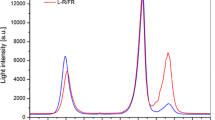Abstract
The elongation of the fourth internode of ‘fully green’ Chenopodium polyspermum L. is modulated by far-red light (FR) given in addition to the main light period. Two different types of organs are responsible for the photoreception of FR producing the end-of-day effect; the stem and the leaves situated just above and below the reacting internode. Photoreversibility can be obtained within certain limits in the two organs. Evidence is presented which shows that in the ‘fully green’ plant there is an interorgan reaction whose primary reaction is the photoconversion of phytochrome.
Similar content being viewed by others
Abbreviations
- D:
-
darkness
- FR:
-
far red light
- R:
-
red light
- P:
-
phytochrome
- PFR :
-
phytochrome in the FR absorbing form
- 9+15 D (or light treatment):
-
photoperiod of a 9 h main light period followed by 15 h of D (or light treatment)
References
Berger, A., Fouletier, B., Lück, H.B.: Une technique pour recherches histogénétiques et biométriques. Nat. Monspel. Ser. Bot. 17, 15–19 (1966)
Black, M., Shuttleworth, J.: The role of the cotyledons in the photocontrol of hypocotyl extension in Cucumis sativa L. Planta 117, 57–66 (1974)
Downs, R.J.: Photoreversible control of elongation of Pinto beans and other plants under normal conditions of growth. Bot. Gaz. 118, 199–208 (1957)
Garrison, R., Briggs, W.R.: The growth of internodes in Helianthus in response to far-red light. Bot. Gaz. 136, 353–357 (1975)
Jacques, R.: Etude par spectrophotométrie in vivo de quelques propriétés nouvelles du phytochrome. Physiol. Vég. 6, 93–116 (1968)
Jacques, R., Chabbal, R., Chouard, P., Jacquinot, P.: Mise au point d'un illuminateur spectral à usage biologique. C.R. Acad. Sci. 259, 1581–1584 (1964)
Jose, A.M., Schäfer, E.: Distorted phytochrome action spectra in green plants. Planta 138, 25–28 (1978)
Jose, A.M., Vince-Prue, D.: Phytochrome action: a reappraisal. Photochem. Photobiol. 27, 209–216 (1978)
Kasperbauer, M.J.: Spectral distribution of light in a tobacco canopy and effects of end of day light quality on growth and development. Plant Physiol. 47, 775–778 (1971)
Lecharny, A., Jacques, R.: Phytochrome et croissance des tiges; variations de l'effet de la lumière en fonction du temps et du lieu de photoperception. Physiol. Vég. 12, 721–738 (1974)
Le Noir, W.C.: The effect of light on the cellular components of polarized growth in bean internodes. Am. J. Bot. 54, 876–887 (1967)
Satter, R.L., Wetherell, D.F.: Photomorphogenesis in Sinningia speciosa, cv. Queen Victoria. I. Characterization of phytochrome control. Plant Physiol. 43, 953–960 (1968a)
Satter, R.L., Wetherell, D.F.: Photomorphogenesis in Sinnigia speciosa, cv. Queen Victoria. II. Stem elongation: interaction of a phytochrome controlled process and a red-requiring, energy dependent reaction. Plant Physiol. 43, 961–967 (1968b)
Snedecor, G.W., Cochran, W.G.: Méthodes statistiques, 6e ed. Paris: A.C.T.A. 1971
Vince-Prue, D.: Photocontrol of stem elongation in light-grown plants of Fushia hybrida. Planta 133, 149–156 (1977)
Author information
Authors and Affiliations
Rights and permissions
About this article
Cite this article
Lecharny, A. Phytochrome and internode elongation in Chenopodium polyspermum L. sites of photoreception. Planta 145, 405–409 (1979). https://doi.org/10.1007/BF00380093
Received:
Accepted:
Issue Date:
DOI: https://doi.org/10.1007/BF00380093




